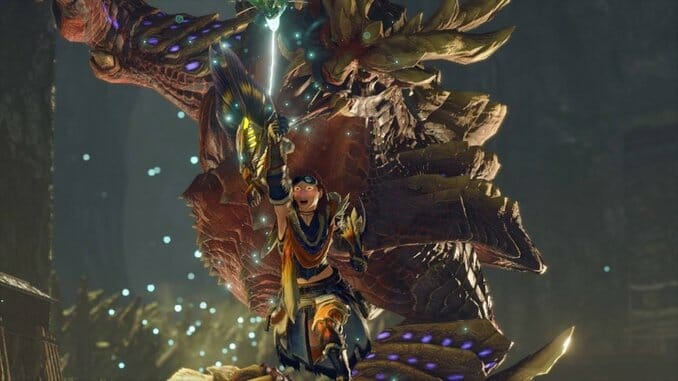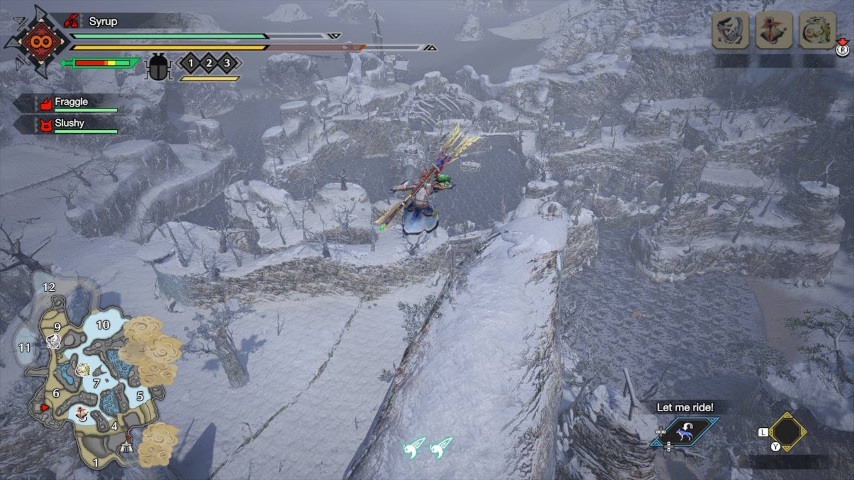
Down the path from my camp, there is a grassland full of bovine creatures which swirl between the sun soaked hilltops and the dark valleys between. To get there I must descend into a narrow path within the forest, walk among the arcane holes that line the caves jutting out from the hill, cross the bridge which conveniently provides a shortcut across another decline, and then ascend up to emerge out from the trees into the hilltops.
Atop the hills I can only walk so close to any of the animals. The bovines mind their own business eating grass, huddling together for warmth. When I walk within 10 feet of them they begin to move away out of fear. Some turkey-like creatures walk down in a line and come to a confrontation with the four legged grass eaters. On a far off hilltop, a canine observes its possible prey, waiting for a safe moment to steal a meal.
This is not a place in Monster Hunter Rise, but a preserve that is about an hour walk from my house. None of these elements could really exist in Rise the same way that they do in this environment because Rise is a videogame that places the player’s volition above everything else. There are no risks of breaks and bruises hiking down the rough parts of a hill. The animals don’t signal or have a need for their own space which they deserve. There is no respect for the environment when moving through it. Through the animals, foliage, and rock there only exists an arena catered to the player’s whims.
As the series has run so long, many will already know whether they enjoy Monster Hunter or not. It isn’t about getting a clean kill without taking any damage; it’s a game focused on the trade-offs that take place in a fight. Your sword is heavy, and even at their fastest your character is sluggish. Opposing you is a large wyvern who can fly anywhere on the map, flip around, and maybe even shoot fire at you. You aren’t going to get out of any fight unscathed, and a single fight is a long haul that can take up to an hour at the higher difficulties. The brand new Monster Hunter Rise doesn’t make any major changes to this formula but it does change the landscape and speed these moments exist within.
Like the title’s name, one of the most major additions Rise brings to the series is the ability to access any part of the map through vertical movement. I don’t mean that there are ways of accessing traditional monster hunter areas through climbing vines. Rather, environmental elements that once blocked players into specific narrow paths have now all opened up and become climbable.
The player is given access to a new tool known as a “wirebug” which is essentially a limited use grappling hook that can be used to climb anywhere. And I mean anywhere.
If there is anything that still has me completely in awe every time I go to hunt, it’s that I rarely find any boundaries I can’t break in Rise. Mountains can be sprinted across and gaps leaped over. This isn’t necessarily impressive in the context of other open world games which tout these minor features. But as a Monster Hunter player for five games prior to this, I still have to adjust my thinking every time I play.

On top of the wirebug, a new buddy known as a “palamute” is introduced to the player, which can be mounted to double the player’s speed around a map, making travel effortless. Prior to this moment in the series, getting to a monster meant finding a meticulously specific path into certain areas by walking around each space with my slow character. Then, I may have had to search multiple areas for their entrails before actually getting to them. Now I go into a map, I see the monster on my HUD, and I bee-line straight to them.
Another addition to Rise is the ability for players to control monsters during their mount. Rather than stabbing away at a monster’s weakness, mounting now provides players the opportunity to participate in a battle between monsters. Many times when a monster is mounted, another nearby monster will come into the area for a battle. This gives the player the opportunity to experience monster attacks from a side of control rather than strategic defense. On top of this, it also provides players with extra material drops outside of the monster being hunted.
These major changes, along with some other minor alterations, create a hunting experience that feels smoother than any of the games prior to this point. Nothing ever feels like it can be blamed on the awkwardness of controls or obtuse information. Things just work a lot of times without having to think much further past the initial point. It feels nice, but in a lot of ways my favorite parts of the Monster Hunter series was providing space for awkwardness and obtuse information to exist in. Learning what was good to cook for my character, how to use specific weapons, and understand a map all took time. Now these things all have been somewhat simplified, or they just work from the get go.
In terms of setting, the player begins in a fictional village inspired by Feudal Japan, when their character officially comes of age and skill to become a village hunter. Hunters are not empirical scholars, nor trophy collectors, instead they are framed as defenders from a series of historical battles which have become known as “rampages”. These are moments where the village was nearly wiped out by the animals living in the surrounding environments.
These rampages are more than a story beat, they are also a new mission type the player has access to throughout the game. In these missions, the player must set up defenses that are automatically and manually controlled as monsters come to attack the village. It’s basically a tower defense style mission.
Like the previous entries, the story is not incredibly involved with the hunts, but instead provide aesthetic and narrative context for the game design. However, these contexts are questionable as framing devices. As the player roams the village hub areas villagers sing, cats and palamutes sleep, and craftsmen go to work on their trade. The village is a space of peace and relaxation. Once the hunt begins, a cutscene plays with a folk song telling a tale passed down by someone unlucky enough to run into the monster. In each of these the monsters are depicted as brutal, ravaging beasts. Yet, many times the beast-like framing of the monsters felt like a flimsy excuse for why I was hunting the monster in the first place.
One of my favorite monsters, Pukei-Pukei, is just a stretchy-tongued, poisonous slime-slinging herbivorous lizard. It is covered with beautiful feathers of various green shades and has friendly frog eyes. It’s just a really goofy monster. However, even considering the fact that it isn’t necessarily a threat to the village, it is still framed as such. In these moments I find the framing of the village falls apart.

The attacks of the monsters are never explained in any detail. Just mysteriously, every so often, a leader monster gathers many other monsters to raid the village with the goal of destruction. By positioning the monsters as beasts unexplainably attempting to destroy, the people of the village are centered as innocent and therefore justified in their claim to hunt and their village. The monsters are simply monsters, and that is reason enough for their slaughter.
There are still moments where Rise leaves me in awe, like when a player jumps over a barrier I assumed would be blocked by an invisible wall. There is still a thrill in the heat of battle being interrupted by a fight between monsters. Yet, in the acceleration and polish of the environment I sit in a neon blue lit cave taking pictures of some Izuchi trying to sleep, and they do not care about my intrusion in their home. In this moment I think of the hill behind my house and how we create ecosystems we can control for our satisfaction for the sake of the ecosystems in actuality.
This ignored cost of fun hits me as ironic in a moment where the easiest jokes to sling around Twitter are about the ecological impact of NFTs. How are we being critical of our own mediums which we create and are entertained by? By this I do not point specifically at Monster Hunter, but more largely to the culture which brought about Monster Hunter as a desired game experience. The industry has popularized certain forms of play which has made acts of harm become fun while disguising their historical functions.
In a gameplay sense this relates to the design of the games we play and the acts done within. We play games where we “loot” foreign spaces for the sake of our own benefit. We play games where we create homogenous maps for ourselves, uncaring for the way it may be known to others. But also on a development and hardware level, the systems we play our games on exist because of the human rights abuses of miners for “conflict minerals” in countries that are still in conflict with histories of colonial powers. In other cases, the systems are lying in the equivalent of an NFT data center, with lines of computers pumping out games through cloud gaming services.
Games like Monster Hunter are the digital zoo that disguises its empirical and environmental impact behind the curtains of computer hardware and enthralling gameplay systems.
However, it isn’t so simple to say that these factors make games like Monster Hunter Rise “not fun.” That would discount everything I said above. Still, we can be critical of how our fun has been constructed and popularized as a product of culture. Then we can work towards changing it.

Picture taken at hill nearby my house.
Monster Hunter Rise was developed and published by Capcom. It’s available for the Switch.
Waverly is a trans game artist and freelance writer. She has written at Uppercut, Into The Spine, and Fanbyte. You can find her on Twitter @hotelbones.